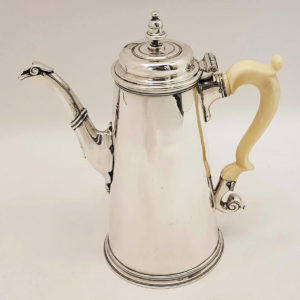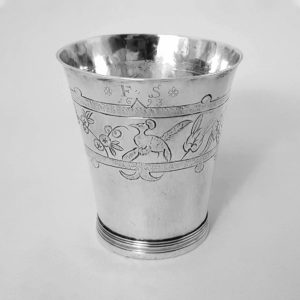John Richardson
John Richardson
John Richardson, London silversmith, apprenticed to plateworker Henry Greenaway 1661, free 1669. Richardson seems to have continued to work with Greenaway until his retirement in 1670 when Richardson took over the premises and bound his first apprentice Walter Arden. Richardson had both a workshop and an active retail trade and during the 1680’s he was busy making cups and tankards with the exotic flat-chased chinoiserie decoration fashionable at that time. He also produced altar plate for Westminster Abbey supplied by John Thursby. John returned to his home town of Worcester in 1695. Died 1698.
John’s mark of “IR” monogram in script, in the Italian hand, is similar in style to other aspiring silversmiths aiming at the top end of the market, such as Abraham Chair and John Bache. He used the same mark throughout his career.
John’s younger brother Samuel was apprenticed in 1663 to Edward Decayne, a shopkeeping goldsmith specialising in jewellery. Samuel moved back to Worcester in 1674, died 1711.
A second London silversmith named John Richardson (known as John Richardson I) was apprenticed to Richard Watts 1715, free 1723. Two marks (New Standard and Starling) entered as largeworker 1723. According to Grimwade, Richardson’s career as silversmith possibly didn’t last very long and he took up service as a soldier to King George II.
-


1734
John Richardson
9878 George II Silver Coffee Pot
Sold
A good plain style antique silver coffee pot with straight tapering sides, a shallow domed lid, and a shaped ivory handle. Uninscribed. Good gauge silver and excellent colour. Contains 1050 ml. Weight 917 grams, 29.4 troy ounces. Height 23cm. Spread 21cm. Diameter of base 11.7cm. London 1734. Makers mark “R.I”, mark not in register, possibly John Richardson I. Sterling silver.
-


1692
John Richardson
9890 William and Mary Chinoiserie Silver Beaker
Sold
An early English antique silver beaker of plain tapering design with simple foot wires. Dating from the late 1600’s. Compact size. Charmingly decorated with a band of hand chased decoration of birds and foliage in the Chinese style known as “chinoiserie”. To the front there is a hand engraved prick dot design containing “F.S” and the date 1693. Excellent patina and hand beaten finish. Contains 160 ml. Weight 74 grams, 2.3 troy ounces. Height 8.1 cm. Diameter 7.2cm. London 1692. Maker John Richardson, a prominent cup and tankard maker known for chinoiserie silver. Sterling silver.